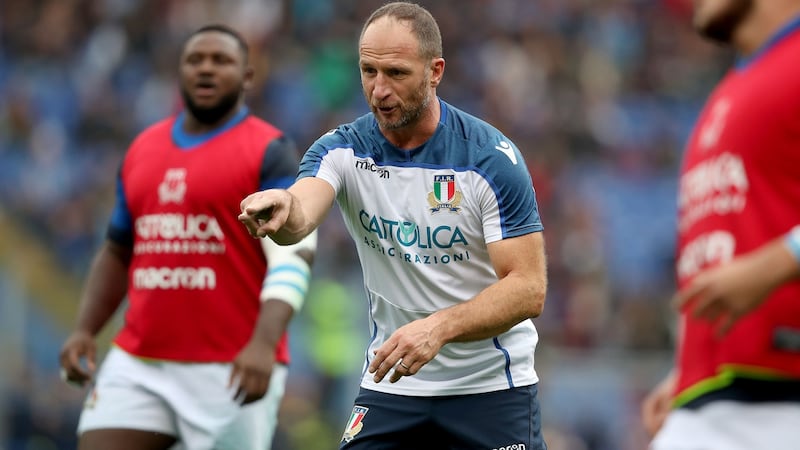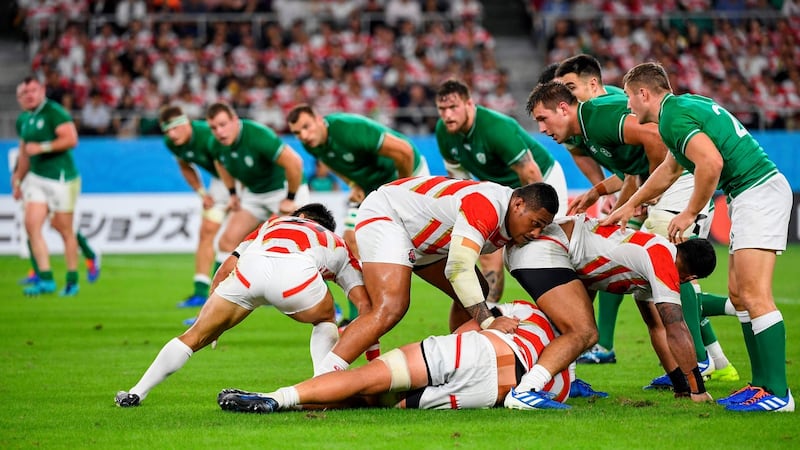Theoretically, Italy in Rome should provide the Ireland coaches with some breathing space.
Comparisons between the current management and what went before is clearly unfair. There are similar faces but one missing ingredient and by all accounts the methods of success in the previous decade had become too strenuous.
Change was needed, but the process can be slow and arduous. I remember how long it took the Munster, Ulster and Connacht players to get used to new, highly specific methods. We were agonisingly close to being a collective force in November 2013 against New Zealand. That was building into a historic day, until the system crashed.
Come March 2014 in Paris, we understood the playbook.
Gordon D’Arcy: The situation Ireland find themselves in is down to management
Gordon D’Arcy: This could become Ireland's worst ever Six Nations
Gordon D’Arcy: Ireland’s Six Nations could hinge on laying Cardiff ghosts to rest
Gordon D’Arcy: Irish lineout has to move past mess of 2020 for the Six Nations
Any tangible success will make players follow the process that got you there. It becomes harder to stay the course when defeats start to stack up.
The current playbook – essentially, Mike Catt’s attacking philosophy – has yet to be learned by this Irish squad despite plenty of time on and off the field since December 2019. The exam results do not lie.
Unfortunately, there is insufficient evidence that Ireland will cut Italy open with fast breaking rugby
The attack coach knows precisely what Italy will do on Saturday because until November 2019 he was their attack coach. He also knows their limitations.
Catt also has valuable evidence from Twickenham 10 days ago. The Italian approach is not dissimilar to France in that they will kick the ball long to Ireland’s backfield. The English ran riot because Elliot Daly, Anthony Watson and Jonny May were given licence to counterattack. The fullback and wings combined for four of their six tries.
If a similar paragraph can be written about Hugo Keenan, Keith Earls and James Lowe, everyone will be floating on good vibes all the way over to Murrayfield.
Unfortunately, there is insufficient evidence that Ireland will cut Italy open with fast breaking rugby. That is not a slight on Keenan, Earls or Lowe. Running from anywhere is in this trio’s nature. Chasing up-and-unders is a learned skill. If we see the latter as opposed to the former in Rome then the coaching message was lost somewhere between the training paddock and game day.

The coaches are responsible for that disconnect, not the players. The modern coach’s primary role is to prepare players to perform, regardless of the situation.
There is no substitute for experience. Catt and Andy Farrell have been in a far worse situation than their current predicament. They were key members of England's collapse during the 2015 World Cup. Same goes for Simon Easterby and Richie Murphy, who were part of Ireland's 2019 nightmare. Paul O'Connell and John Fogarty have been around the block a few times as well while Gary Keegan is no stranger to adversity.
All those lessons should enable them to find a way to harness the wildly enthusiastic work rate of these players.
Catt knows that Italy will invite Ireland to empty every bullet in the chamber. So, it becomes about ensuring Earls – for example – does not spend 80 minutes sifting through the wreckage of all the collisions in the hope of feeding off some scraps or be forced to leap and slap the ball in-field for a support runner.
Play the game that suits the talent at Ireland’s disposal.
I've mentioned it before but Ireland's best players need to show more of themselves
That is why I am still scratching my head over John Cooney’s exclusion. Cooney is fourth-choice scrumhalf behind Conor Murray, Jamison Gibson-Park and Craig Casey but watching the Pro 14 last weekend he looked the best option to wear number nine on Saturday evening. He was with the squad for France, as cover due to Murray’s injury, so he cannot be miles behind in terms of knowing the plan.
Farrell appears to be edging towards Casey as Murray’s long-term successor, although he did not believe the 21-year-old was ready to chase the win against France. Cooney must be resigned to his fate, as he continues to play the best rugby of his career in an Ulster jersey. It might come back around for him, but he needs a lot of luck, as current form does not appear to count when it comes to selection at scrumhalf.
Such calls – scrumhalf, outhalf, prop, hooker, backrow – are forgivable, until you lose the opening two rounds of the Six Nations.
I've mentioned it before but Ireland's best players need to show more of themselves; that means Garry Ringrose and Robbie Henshaw creating space for others as much as their heroic individual runs.
This goes back to fundamentals. If the crispness of passing remains an issue, then Ireland will find themselves in a battle for the Wooden Spoon and that is unacceptable for everyone involved (sponsors, committee men, players, supporters – everyone).
One way or the other, we are going to learn more than we usually do from a trip to the Eternal City
The alternative to revealing the team’s new personality is to revert to type; Murray and Johnny Sexton at halfback with 20 carries by CJ Stander, into waiting Italians, and a few clever plays by the captain to create tries. You know, one of those reactive Ireland performances that we became famous for back before we were considered a tier one country.
You know what an ‘Irish performance’ looks like; solid set piece, punishing carries in midfield by Henshaw and Ringrose – with one of them pulling up as a result – before some speed of thought by Murray or Sexton picks the lock.
That might prove to be enough against Scotland and by then, who knows, England could have lost some big names as good old pride in the jersey, and a desire to play for each other, earns Ireland a third-place finish.
Finishing third – at this stage, three straight victories would be incredible – as opposed to fifth will vastly improve the bottom line and increase plenty of players’ chances to make the Lions squad. Individual motivations aside, Farrell and O’Connell will probably drag one or two wins out of this group before the championship ends or is ended by Covid.
But imagine if Ireland click into the Farrell era with coaching that makes you want to apologise to Catt and Easterby for the grief that has been sent their way of late.
That is where the Team Of Us finds themselves entering Stadio Olimpico. This is a dangerous fixture, another crossroads if you will, where the team will either limp onto Edinburgh or put Gregor Townsend and Finn Russell on notice.
One way or the other, we are going to learn more than we usually do from a trip to the Eternal City.
Watching Seán O’Brien’s timely assist for London Irish at the weekend reminded me that no Irish player has inspired in this season’s championship like Seánie used to.
You can’t win in the Six Nations without at least one Seán O’Brien in the team – 2021, just like 2019 and 2020, will pass Ireland by if someone cannot rise above the rest on Saturday. It starts with the coaches empowering individuals to take chances. If nerves lead to mistakes, if the collective continues to splutter, maybe the current process is not working.

Let offside line breathe
Speaking of crossroads, something needs doing with the offside line. Enforcement is simply not happening. The referee must watch the play but calls from the touch judges have been wildly inconsistent. If at all.
The players will figure out how loose the touch judge is when it comes to policing offside and act accordingly. That is why the ball so rarely gets to the edges.
I watched the Rugby League match between the Indigenous All Stars and the Maori. So much entertainment is created by multiple playmakers charged with being creative every five or six plays. I also counted three or four straight red cards if we cross code. Rugby union does not need to mimic their close relatives when it comes to defensive lines. The 10-metre run up to smash a ball carrier with a three-metre run on to possession is so dangerous, it’s ridiculous. The shoulder charge gets you ‘on report’ and maybe ‘in the bin’.
It can always get worse for rugby union and concussive injuries, but the pendulum can be swung gently in favour of more space for attackers. Nothing drastic – like we see in League – but a clear metre or two behind the hindmost foot for defenders would be welcome. It would also be easier to see an infringement. It might even sort out the crocodile roll.
We either endeavour to reward the attacking team or keep tweaking until a bastardised version of Rugby League exists.
Anyone interested in quicker rucks, disorganised defences and plenty more space?
















